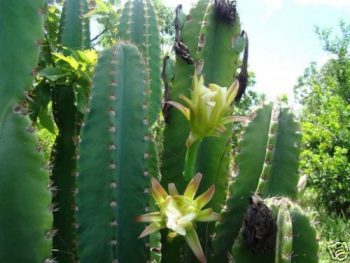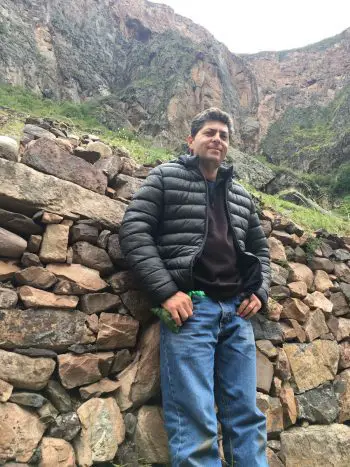Contributing writer for Wake Up World
What is actually known about the psychoactive substance mescaline and its relationship to humans, considering a millennia old bond between the two? Although the scientific research into this question has begun over a century ago by a German pharmacologist Louis Lewin who published the first study of the Peyote in 1886, the psychological material on the subject was and still is rather limited in spite of decades of research. The observed and recorded data collected during mescaline experiments conducted in clinical settings during the first half of the 20th century has provided little understanding of this phenomena overall. And the simple fact that mescaline is a naturally occurring alkaloid in both the San Pedro and Peyote cacti of Peru and Mexico, is hardly sufficient to explain its deepest bond with humans throughout history.
I do intend to explore this subject in depth, the existence of these mysterious plants and their purpose on Earth, in my next book which would be wholly dedicated to the sacred cactus, talking from a 12 years of ongoing experience working with it in a shamanic way. But for now, I would like to invite you to a brief overview and start a conversation.
[pro_ad_display_adzone id=”110028″]
While neurologists, physiologists, biochemists, psychologists and psychiatrists were involved in the study of the mescaline phenomena and some useful data was gathered, the research has not met satisfactory expectations for many of those genuinely interested in this subject. Perhaps it had to do with the fact that the experience itself and not the chemical compound that triggers it, is responsible for the healing and inspiration it has to offer.
Both the San Pedro and Peyote cacti were used as sacraments going back millennia and the unbroken shamanic traditions of North and South America continue to walk together with humans side by side. The oldest cultures known to history whose life has revolved around the sacred cacti were the Chavin in Peru and Huichol in Mexico. Although archeology is confident to ascribe the period in which the culture of Chavin thrived as being between 1,200 BCE and 200 BCE, the true age of this mysterious San Pedro culture could have a much earlier beginning. The temple of Chavin de Huantar located in Ancash, Peru, which was discovered in 1919 is standing still as a silent witness to this mystery that perhaps, will never be solved. The Huichol Indians of Mexico, on the other side, are the inarguable guardians of the ancient Peyote tradition. Traveling to both continents and working with natives, one is amazed to find cultures with a similar content but different “flavor”. A deeper immersion into the topic in its cultural context would yield a greater understanding not only of the subject matter but also of the basis for the formation of the first dynamic and living religion generally called shamanism; a religion fundamentally based in psychedelic experience. But the common academic view of these native cultures serves as a barrier between the West and the indigenous peoples who possess a practical knowledge about the subject; a knowledge that has been accumulated over thousands of years and passed down from generation to generation yet that has been mainly ignored by mainstream science and viewed somewhat as a “madness of the savage”. Perhaps the few words of the shamans spoken in whispers were found insufficient for the purpose of conducting an investigation using scientific methods to form a hypothesis about the phenomena, which predates reason. But even the shamans’ words should not be taken as a substitute for knowledge, for this can be achieved only directly from the experience – something that is generally avoided by scholars who feel they can write on the subject without participating in rituals themselves and actually ingesting the psychoactive plants. And unless this was done, nothing written on the subject would bear enough weight to result in a thorough understanding.
Perhaps because of this approach, which is mainly based on arrogance, an erroneous assumption characterizing shamanism as pathological behavior, has been formed. What else should be expected and how far can this research go when those conducting it have done it for the purpose of understanding schizophrenia, by trying to mimic mental illness with mescaline, assuming that the two, if not exactly the same, are similar. By ascribing mescaline into a category of a psychotomimetic, or mimicking-madness drug, psychiatry has lost the trail from the start by comparing the shamanic state of consciousness with schizophrenia. This whole area of research had to wait for Aldous Huxley, who I often quote and admire, to be taken to the next level. Huxley was introduced to mescaline in the spring of 1953 and taking it himself under the supervision of Humphry Osmond, an open-minded psychiatrist, who in my opinion should be held as an example in the field, had quickly recognized its extraordinary quality and the mystical state of consciousness that it facilitated, an experience which has been generally seen by mainstream psychiatry as a psychotic reaction of the intoxicated mind. If that would be the case, then considering my 12 years of ongoing work with mescaline-containing cacti – in particular San Pedro, having done by now nearly a thousand ceremonies, each one lasting between 10 -14 hours totaling over 10,000 hours spent under its influence, my mental state would be equal to that of psychotic patients whose sanity has been long lost to hallucinatory worlds and my place would be in a mental asylum sharing a room with Napoleons, instead of raising a beautiful family, writing books and helping other people to reconnect to themselves, find healing, balance and clarity in their lives.
But even Huxley who was undoubtedly among the brightest intellectuals of the 20th century, did not grasp the difference between an isolated alkaloid and an ingestion of the whole plant in a shamanic setting. While admitting the mystical experience, he didn’t have a chance to fully immerse himself into the mystery found in rituals rather than clinical investigations. Perhaps during his time the urgency to reveal its full healing potential wasn’t there as it is today. Although the ancient shamanic tradition has never disappeared since it was a global phenomenon since the beginning of time and a precursor to religion at large, it has now surfaced to a greater visibility, and perhaps for a specific reason. This, I believe, has to do with the self-destructive path humanity has taken. Being at a crossroad, we as a species can now decide our future. Further destruction of the natural environment and disconnection from our spiritual roots, fueled by the ever increasing influence of the technological era, will lead us into oblivion if not balanced with conscious living. And here is where the sacred Teacher Healer plants are coming to play. With their help we are able to restore the balance within and consequently outside ourselves. They can help us to realize our humanity beyond the social barriers of race, religion and social status and feel the unity with the rest of the natural world, realizing the same love for life in all living beings; which in itself leads to respect and peaceful coexistence. On a more personal level, these Teacher Healer plants are capable of freeing a person from fears, which are often found at the root of depression. They can positively interfere in a destructive behaviors including drug and alcohol addictions, giving a person a second chance for a healthy, happy, moral and productive life.
Seeing this and other types of profound and lasting healing in practice over the years, it is rather mind-boggling for me to see mescaline, an alkaloid that consistently inspires contemplation and a deep ethical viewpoint, being classified as a schedule 1 drug in the Western world and placed in the same category as dangerous drugs like heroin under the attribute of being highly addictive and having no medical value. Both statements are blatantly false, for it is not addictive and certainly has medical value, in fact, a medical value that is hard to overstate. Here we are not even talking about “oranges and apples” in comparison, but more like oranges and toxic waste. Whether or not this insane prohibition was based either on insufficient data and limited understanding or on a fear-based paranoia, something that extends over other psychedelics as well is unknown. But what is known by the practitioners is that the medical and psychological effects caused by the administration of mescaline often results in an exceptional healing experience. A personal transformation of the individual can have a positive impact on both the person’s life, his family and society at large, for a person is a constituent of the society, and an essential composite in its structure which can play a role in reshaping it as the cultural influence shapes the individual. Apparently, it is not enough to read ancient scripts and texts that serve as guides to life, if we still are living in a violent and toxic world in which our level of destructivity has risen to a dangerous tipping point. The mescaline-containing cacti can serve as a catalyst for personal and societal change. These sacraments however, should never – in my opinion – be taken recreationally or carelessly, for in doing so, the sense of the sacred communion and its potential for healing is diminished. They should be taken in a shamanic setting with the proper mindset, guided by an experienced people whose knowledge of these plants is not derived from books. One way to look at this experience is to see yourself going on vacation to another place where you are free from your social role and your paradigm, which during this travel to the mysterious landscape of the mind, may undergo transformation – providing profound and positive changes in your worldview, resulting in self-discovery and well-being.
I didn’t want to spend years of my life acquiring academic credential just to prove someone wrong or upset some people. Instead I have chosen the shamanic approach, which is more ambiguous and yet, I feel, more revealing. And instead of being preoccupied with the botany and chemistry of the plant and measurements and location of ‘hallucinations’, I chose to learn about it from the source, which is the shamanic experience itself.
An experience however, should not be confused with an experiment for the two are not the same. An experience is learning by involving yourself in something – in this case in the shamanic ritual, which includes the ingestion of the whole plant in nature with a proper intention for learning and healing. An experiment in this context is generally a scientific procedure undertaken to make a discovery or test a hypothesis that usually involves others on whom isolated alkaloids are to be experimented on. While Peruvian and Mexican tribes were experiencing Peyote and San Pedro over thousands of years, scientists learned about mescaline at the beginning of the 20th century and began experimenting on monkeys subcutaneously injecting them with large doses of mescaline causing poor, caged animals to reach catatonia by overloading their nervous system with an experience they are unable to process; a creepy and barbarous method of study, most people would say. It would be more merciful, in my opinion, to force a monkey into bungee jumping or parachuting.
This unnatural and clinical approach to administrating mescaline was also applied to humans, who are built to process stimuli and as opposed to the primates, have greater mental and emotional capacities to receive, express and assimilate the psychedelic experience, yet still investigators were not brought much further in the understanding of the phenomena at large. The reason why is in the fact that the mescaline had been first isolated from the plant, which in itself was uprooted from its cultural context in which this experience is respected, understood and held as sacred throughout history. Being alienated from its biological body and cultural context and administrated in an unnatural way by people whose psychological background does not support a spiritual perception of reality, the results could not be other than confusing, and a language which has been spoken and understood by the shamans of Peru and Mexico for thousands of years was interpreted as chronic mescalinism, psychosis and schizophrenia. Being preoccupied with causative factors for ‘hallucinations’, its localization and optical effects, more than with the question of consciousness, science has missed the point. It took Aldous Huxley to draw attention to the spiritual context of mescaline. Perhaps, due to his intense study of eastern philosophies, it wasn’t hard for him to see the parallels between mescaline and the mystical experiences as related in the ancient texts. Aldous Huxley has written about his mescaline experiences in his epic book “The Doors of Perception”, which took off like wild fire, sparking both delight and critique from spiritual leaders who have seen this as a shortcut to Enlightenment and perhaps were even threatened by the immediacy of the spiritual awakening.
Although being aware of this book, by the time I first read it I had already had many years of experience with the mescaline-containing cactus San Pedro and was rather looking for faults in Huxley’s writing. Instead, I found it to be a brilliant account, albeit I felt, incomplete and not fully reflecting the magnitude of the experience, which would otherwise be available under a different setting. Nevertheless, he has definitely seen the essence and touched the heart of the mystical experience, to which mescaline served as the key, unlocking the “forbidden” doors of perception.
[pro_ad_display_adzone id=”110030″]
As I have myself been interested in the Eastern spiritual paths long before I met shamanic plants, the divine cacti of Peru and Mexico in particular, I could deeply relate to Huxley’s search and feel his passion for the direct spiritual experience of an objective reality. The stupendous beauty of the world engulfed with life and meaning, which is always present behind the veil of the ordinary perception of reality – which can be gently lifted by the grace of the mescaline cacti – is that very same place that has been known for ages by the Sufis, sages and mystics of the East and West. Under the influence of mescaline revelation, one can easily be transported to the room in which Van Gog was painting and writing. One can feel his heart and see through his mind. In the same way, one can find himself sitting next to the Indian babas or walking along the path with a dervish. No in a sense of being transported in time, but by becoming connected to the timeless spiritual teachings of near and Far East. The hidden meaning in the poetry of Rumi, for example, reveals itself in its depth.
After using many substances and plants, sedatives, stimulants and psychedelics, while searching for the path, both in recreational and intentional ways over the many years, I can say with great certainty from my personal experience that mescaline deserves a special place among all other psychoactive agents. The gratitude for its gifts, which have been received and perceived under its influence are difficult to express and its teaching and wisdom I can hardly overstate.
I think it’s crucial for the western science and eastern spiritual paths to expand their outlook and recognize the ancient plant-based shamanic traditions as a legitimate way to self-knowledge, personal healing and an enrichment of the collective understanding of reality.
I was fortunate enough to be chosen a few years ago as a guide to the mescaline realm by a few representatives from the western scientific world. One was a German biologist and another was a Russian Doctor in Sciences whom I took to visit a few places in Peru and Bolivia including some ancient caves. From the other side, I had an opportunity to introduce to mescaline a well-known and respected Yoga teacher Karta Singh, one of the first students of the Yogi Bhajan who brought Kundalini Yoga to the West in 1968. You can read about it in the book “Meetings with Sergey Baranov: Sacrifice Your Fears for Your Vision” by Frederic Swiercz.
What was interesting to me is that the spiritual teacher and the Ph.D in sciences were very different and interesting people coming from parallel environments and backgrounds, and yet both have expressed their highest appreciation and gratitude for this new experience and for an opportunity to see the world through a different lens. Certainly a chapter in my next book which will be dedicated to a broader understanding of evolutionary shamanism and its potential role as a unifying force between religion and science – two major and important aspects of the human experience.
It is time for unity. There is no healing in confrontation and competition. Cooperation and an expansion of consciousness should be chosen instead. By uniting different disciplines, we can make a greater contribution to the overall understanding of reality and ourselves, thus affecting a positive change in the world.
On The Shamanic Path: Shrink Rap Radio Interview with Sergey Baranov
It was encouraging to receive a number of emails from professors in psychology who have shown an interest in the subject after watching the interview I recently gave to Dr. Van Nues, Ph.D from Northern California. You can watch it below.
Please also like and share our newly created Facebook page, which is dedicated to the cause: Facebook.com/HuachumaWasi
Related reading by Sergey Baranov:
- Why Consciousness Expanding Plants Are Feared And Deemed Illegal
- Psychedelic Spirituality
- Between Life and Death: How Peyote Saved My Life in Mexico
- Precious Metals vs. Precious Life: Destruction Of The Amazon
About the author:
Sergey Baranov is the author of ‘PATH’, a book that will be of interest to any spiritual seeker who seeks honesty above all else. Living in various countries and growing up in different cultures, Sergey gained an understanding of the essential, a core commonality of human experience that lies beneath the differences to be found in every culture. By walking different paths and seeing through their limitations, Sergey found shamanism as a unifying path for all people regardless of their cultural background. He currently lives in Peru with his family where he conduct monthly San Pedro retreats.
You can find out more in his book “Path”, available here on Amazon, or follow Sergey on Facebook at Facebook.com/HuachumaWasi.
[pro_ad_display_adzone id=”110027″]









